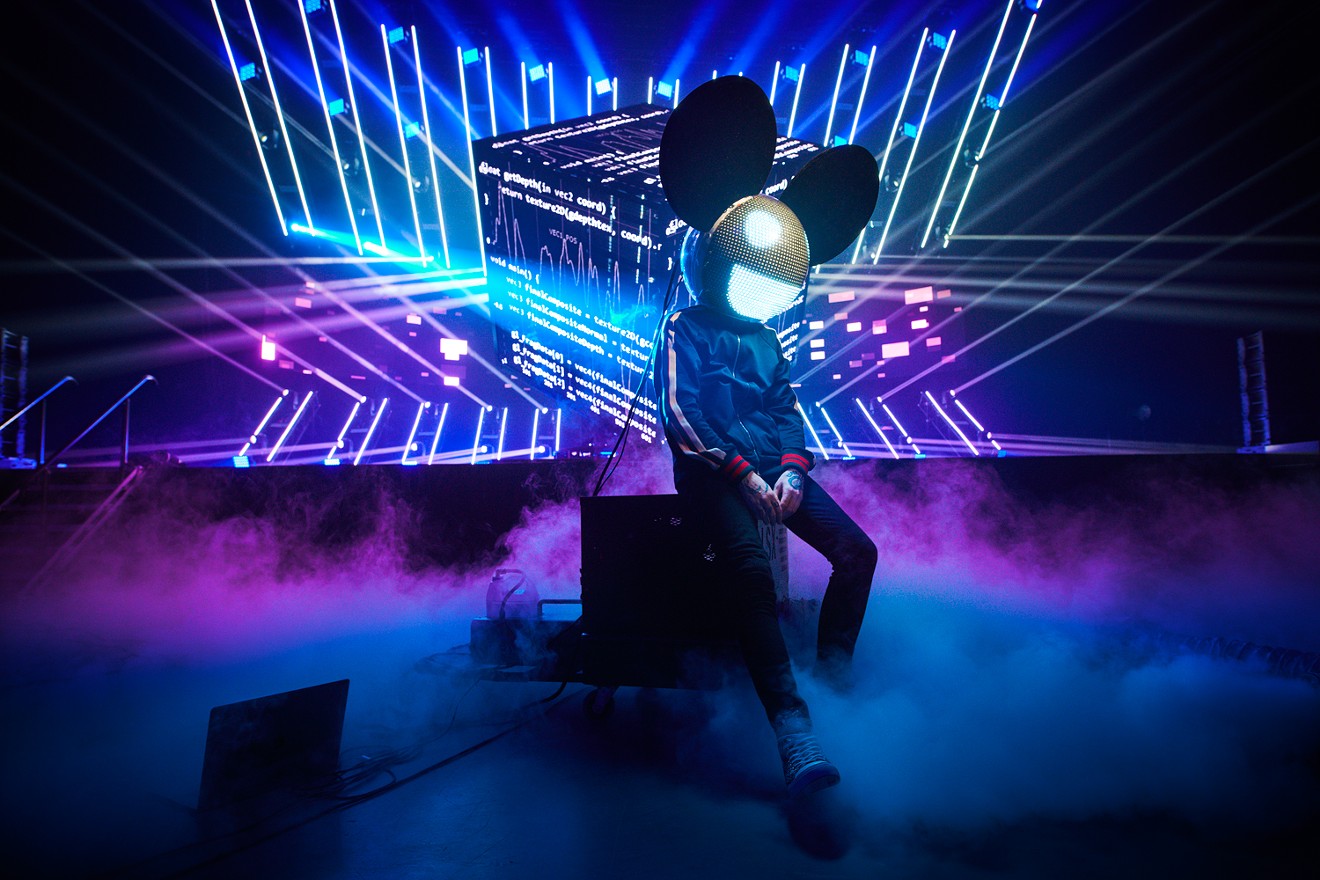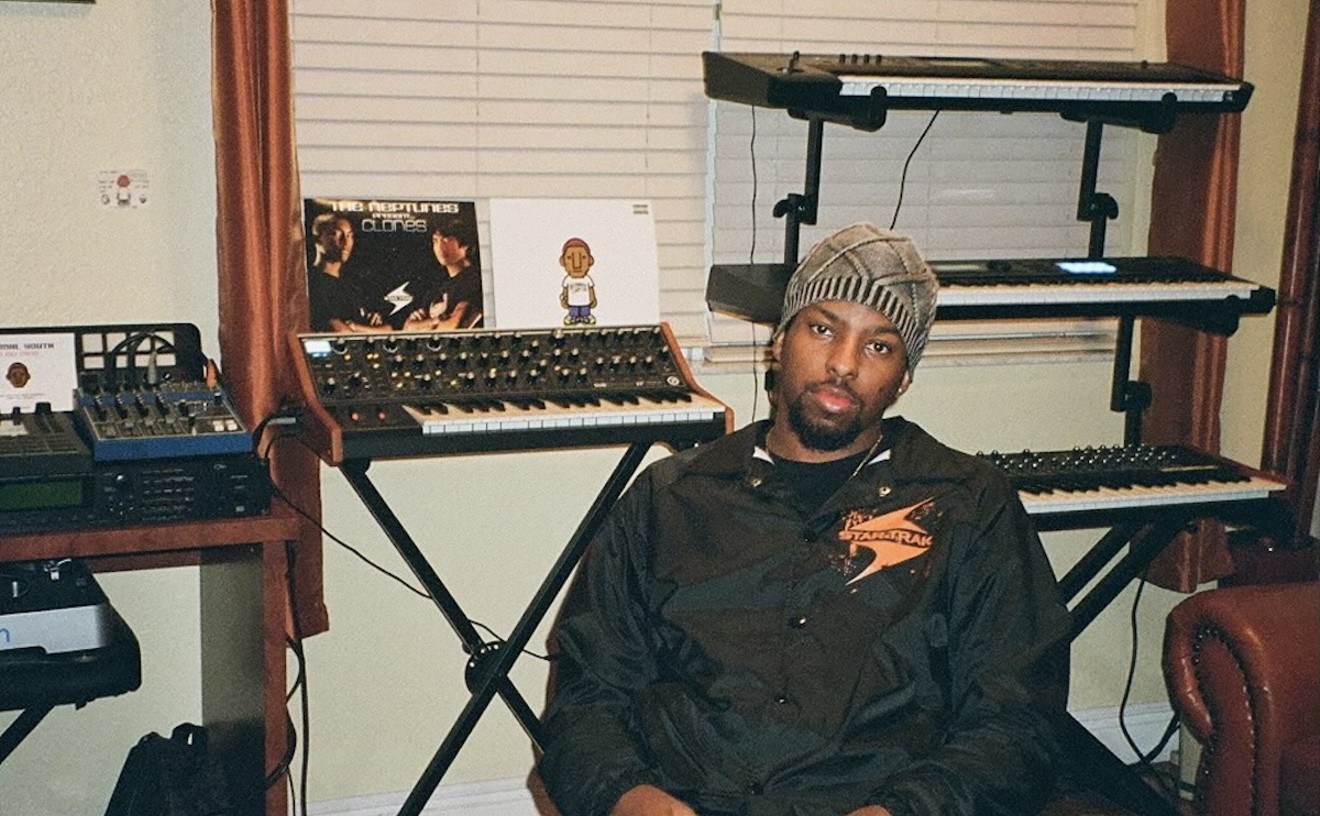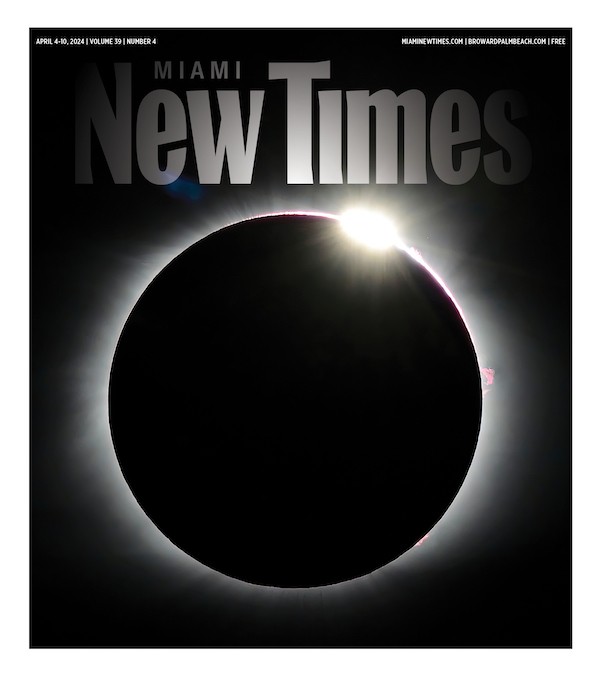The lobby is warm and busy, decorated with smiling portraits of the Kids in the Hall cast and other Canadian celebs. Somewhere in the building, newscasters deliver headlines, actors film sitcoms, and pundits argue about hockey. But the scene in Studio 40 is perhaps most peculiar. A lanky man with a green Space Invaders character tattooed on his pale neck is glued to dual computer monitors. His fingers type furiously between cigarette drags. The ashes and butts collect in a ceramic bowl between an empty coffee cup and Coke can. He's the head of a makeshift command center, leading a team of 12 toward a strange digital glory. There are no windows here, no trace of the sun or snow outside — just Joel Zimmerman, his cohorts, and the ever-ominous presence of a 21-foot-tall, 22-foot-wide, moving
“My wife went to Florida,” he laughs. “It's like, 'OK, cool. I'll be here in my box if you need me.'”
In about a month and a half, Zimmerman will leave this concrete cave and fly to Miami too. When he dons his famous LED-laced mouse helmet, he'll transform from curmudgeonly coder to international superstar DJ/producer deadmau5. The tens of thousands of hours split into 18-to-48-hour work sessions will culminate in a mind-blowing audio-visual experience
It will stun and surprise with cutting-edge crispness and eye-popping visuals personally designed and rendered by Zimmerman. The massive, three-sided cube will tilt, rotate, and push the boundaries of what a live stage production can be. It'll be astounding, and in about 90 minutes, it'll be over.
“I need everyone to know how much of a fucking insanely stupid technological feat this is,” Zimmerman says. “I'm not just some fucking dick who gave a VJ $500 a show to monkey around with some bullshit. That's
Born January 5, 1981, in Niagara Falls, Ontario, to a visual artist and a General Motors plant worker, Zimmerman began DJ'ing in the '90s. He took his stage name from a dead mouse he found in his computer. In 2009, deadmau5 made his humble Ultra debut. That year, he rose to prominence in the burgeoning EDM scene via the jaunty electro-house hit “Hi Friend!,” the ten-minute progressive-house epic “Strobe,” and the career-defining anthem “Ghosts 'n' Stuff.” He also earned the first of his six Grammy nominations to date. The albums Random Album Title and For Lack of a Better Name had made him one of the scene's hottest rising stars, but his stage production consisted of a simple LED screen and some clever visuals.
Computer mouse clicks sounded while a loading bar flashed onscreen, giving way to a desktop littered with folders. One opened to reveal a count to five and his mouse-head logo. Zimmerman walked onstage sans helmet, saluted his fans, and took his place behind table decks. It's exactly that kind of low-budget environment that led him a year later to create the first version of what is now his signature cube.
"I wanted to do something,” Zimmerman says. “I didn't want a back LED wall and a picnic table with a black cloth on it and two CD players. Sure, it works for some people, and it's a very, very easy way to make a lot of fucking money and spend none. It's just about your business model. It's about where your passions are.”
His passions have always lain in the technical. Zimmerman’s first computer, an Atari ST, ran on DOS. He was heavy into gaming but, having been born in 1981, was a little too ahead of the professional-game-streamer generation. He went into graphic design and got his first job making coupons in CorelDRAW for a local Toronto newspaper. He applied his skills to web design and landed a gig with the full-service interactive development company WebNet Logics Inc. It was a grind, but it paid the bills while he dicked around making chiptune music for fun.
He took side jobs, one of which was designing a MySpace page for the death-pop band Orgy. It was lead singer Jay Gordon who first asked Zimmerman about the mouse head he used for a web design logo.
“He was like, 'If you ever perform live, you should wear it,' and I was like, 'Fuck you,'” Zimmerman smirks. “Twenty years later, who's the idiot now?”
Back then, deadmau5 was big in what was called the “demoscene,” an international computer-art subculture whose heroes were those who produced the most awesome audio-visual presentations in the smallest files possible. Recording sounds
“I can see where the kids today trying to make music are getting lost in it, because they don't know how [Virtual Studio Technology] works,” he says, referring to the digital production software interface he and other EDM artists use. “They just know how to change a preset, hit a fucking MIDI note, and pray for number one success. Sadly, 90 percent of the industry is that, at least in EDM. I can pick that shit up because I was with it from the very start. I know it in and out. It's not a problem for me, but I can see how someone is like, 'I want to make music, but I don't want to learn all this nerd shit.' Well, then your shit is going to suck. I'm sorry. Get fucked.”
In 2005, deadmau5 released Get Scraped, a 15-track demo album ranging from energetic trance to moody ambiance and experimental beats. He honed his sound on 2006's Vexillology, but it was 2008's Random Album Title — with eight-plus-minute tracks including the industrial brooder “Sometimes Things Get, Whatever,” the progressive dreamscape “Faxing Berlin,” and the soft, vocal-house Kaskade collaboration “I Remember” — that made him a breakout star.
In 2009, he released For Lack of a Better Name. In 2010, MTV hired him as the in-house DJ for its Video Music Awards. Earlier that year, he was a third-tier headliner at Coachella, where he was sandwiched between Vampire Weekend and Public Image Limited.
That's where he unveiled it.
His first cube consisted of two square LED panels in the shape of a box with a top panel cut out in a "w" to reveal deadmau5 and his glowing helmet. It was a juiced-up DJ booth that wowed audiences via neon images and graphics of computer circuitry, Rubik's Cube squares, amorphous smoke, geometric patterns, and little cartoon characters.
Six years later, deadmau5 invested in cube 2.0. The 3D graphics, generated by the game-developer tool Unreal Engine, were a step above their predecessor's, but it was the moving mechanics of cube 2.0 that blew fans' minds. The top "w" panel actually moved and spun. In 2017, he upped the ante again with cube 2.1. He teased fans via a stream of geeky tweets boasting, “The panels are capable of fucking your retinas with 5,000 NiT of brightness per panel at up to a 140° viewing angle with 281 Trillion colors,” adding that the show was “utilizing the shit out of exactly 386,031 frames of video running at 60 frames per second.”
That was about the time he met his current production director, Chris Schroeder.
“The first call I ever got on with him was —” Schroeder pauses a beat, “an interesting and tumultuous one.”
Schroeder was working as an independent production manager for the Chicago-based event promoter React. He organized stage logistics for festivals such as Mamby on the Beach and Freakie Deakie, as well as shows at Navy Pier and the city's Aragon Ballroom. Deadmau5 wanted to take his cube to the historic venue, and Schroeder, having deduced the cube was too large to fit through the Aragon's loading doors, told Zimmerman's managers no.
Schroeder was in Denver when he got a random call from a Colorado number. The voice on the other end demanded to know why he had refused to approve the Aragon date, therefore holding up the whole tour. Schroeder calmly confirmed the cube's cantilever was 64 inches wide and then explained the Aragon's door was 57 inches. There was a pause and a quick “We'll call you back.”
“Sure as shit, a week later, they're like, 'Do you want to be deadmau5's production manager?'” Schroeder smiles. “The best thing I ever did was say no.”
Schroeder persuaded the venue to widen its door a few inches, and such issues became a theme throughout the tour. In multiple cities, Schroeder met with civil engineers to reinforce stages and
Schroeder proved himself indispensable when he commissioned a lighter, more tour-friendly iteration he calls cube light. It cut 2.1's 10,500 pounds to 4,500, and he had two built for about 10 percent of the cost of the first one. When deadmau5 saw it for the first time at the U.K. festival Creamfields, he asked, "Why didn't we do this first?"
When it came to cubev3, Schroeder assembled his own team of handpicked production wizards to bring mythical concepts to life. The initial design did away with the "w"-top panel, replacing it with a full rectangular panel that would place deadmau5 inside a real, honest-to-goodness cube, hidden from the audience. Zimmerman loved the idea. Management freaked out. Who would buy tickets to see deadmau5 if they couldn't see the mouse head?
So they found a way to make the top panel vary in transparency. The first half of the show becomes a game of shadows. Sometimes you think you see deadmau5; other times you definitely don't. Sometimes you see him via live video
Shadows and video feeds aren't quite enough, though, so Schroeder and the team designed a track system upon which the monstrous cube can tilt forward 45 degrees and rotate a full 360, revealing the inside of the cube to astonished onlookers while keeping the mau5 man forward-facing at all times.
“When you're moving 5,000 pounds in any direction at any speed, there's a lot of inertia, so when it stops, it does one of these,” Zimmerman says, jolting himself hard in place. “It's kinda scary at first, but they've told me a million times it's supposed to do that. I'll just get used to it.”
Behind the cube is a massive LED wall flanked above and below by nine to 12 moving lights, scalable for different stage sizes as needed. Each moving light is on a truss structure that is also outfitted in panel LEDs. All the surrounding lights are programmed to match the color and mood of the cube visuals. It suffices to say, the stage is lit.
To design, construct, and transport such a behemoth is one thing. Staying on
“He said it was the first time he'd gone into rehearsals in ten years and everything worked,” Schroeder says. “That's as much of a thank-you as we're ever gonna get.”
As soon as Schroeder presented proof of concept, Zimmerman got to work on visuals. Since the summer of 2018, he's been personally producing and editing all the visual graphics for the hour-and-a-half show. That's feature-film-length content, and it's not just a collection of video clips. Zimmerman has written actual lines of code in a visual programming language using the platform TouchDesigner. These visuals aren’t prerecorded — they’re computer-generated in real time.
There are nods to the work in the show itself. It opens with lines of Apple crash report code on the back LED screen, while the cube depicts accurate keylogger malware script for Windows.
“A game studio would charge like $200 million to do a game that played linearly that long with all real-time graphics,” Zimmerman says. “That's a big fucking job between 48 content developers.”
It's worth the colossal effort. The graphics processing units (GPUs), similar to those found in home gaming systems, render his graphics in real time relative to the position of the cube as it rotates. In layman’s terms, that means images don't rotate with the cube. Rather, it shifts while images of tongue-wagging cartoon freaks or nuclear bomb schematics (yes, real ones) remain seemingly static in relation to the audience's perspective.
“Everyone in the world — I don't care who you are — they're playing video clips,” Zimmerman says. “They're not using real-time GPU-generative content... Now, if I want to change something, I don't have to go open up an Adobe Premiere or After Effects file and re-render the video. It's just changing a few lines of code.”
By his own admission, Zimmerman is no “supergenius.” He had help along the way from friends who work for companies such as Pixar. They'd give him a graph of code here and there to tackle the hardest problems, and he learned the rest as needed. A thick textbook about real-time rendering sits within reach on his desk. It was given to him by one of the book's authors, Angelo Pesce, whom he met at the New York City premiere of the Netflix film Polar, for which Zimmerman wrote the score. He's visibly giddy as he shows off handwritten code for a deadmau5 helmet pixel shader that Pesce wrote in pen on the inside cover.
“There are no mistakes,” Zimmerman gushes. “That's fucking insane.”
He may not be a genius, but in the process of coding this show, Zimmerman has done his part for the culture. During the process, he wrote a hack to use a simulator called FleX by a company named Nvidia inside TouchDesigner's visual platform. After showing his work to his friend at Nvidia, the company reached out to TouchDesigner developers at Derivative, and today Nvidia's FleX is a licensed, in-platform app for TouchDesigner users worldwide.
“It's turned [into] a cool thing that someone else will find useful and use in their project,” Zimmerman beams. “It's a kick in the ass to the guys that are sitting on $50 million to go out and fuckin' spend that money. Pay the fucking nerds, because they're doing better shit than your VJs. Trust me.”
For Zimmerman, that's really what it all boils down to. The $2.5 million in rented equipment, the hours of learning coding languages, and the months spent hunched in front of a monitor — it’s all worth it if he can move the culture forward.
“My balance sheet is almost always at zero because it's just going back-and-forth into this shit,” he says. “I like doing this. I like being here. I like creating. I like tech problems. I like fighting with all these fucking nerds... That's the point I'm trying to make with cubev3, not 'Oh, come listen [to] fucking "Ghosts 'n' Stuff," you piece of shit, and give me your money.' Well, give me your money, because this isn't free.
"I'll play the show for free,” he adds. But the design? “This is what I get paid for, right here.”















